It’s now less than a week to go until restrictions start to ease. On Monday March 29, the stay at home order ends. Although we are encouraged to stay local as much as possible, no doubt we will all feel we can venture a little further afield providing we act responsibly.
From Monday up to six people (or two households) will be able to meet up socially, providing we are outdoors. Which means that going for a walk with friends will be possible.
Let’s savour this moment of relaxation and then look forward to the next on April 12.
Temple Church, which is located just off the left bank of the Thames between Westminster and Tower Bridge, hosts a weekly organ recital on Wednesday’s at 1.15pm. Details here. This week’s recital is available on YouTube
Temple Church, hidden in the backstreets of London’s legal quarter, was built by the Knights Templar, a Catholic military order based in Jerusalem, and was consecrated in 1185. The church is round, paying homage to the Church of the Holy Sepulchre in Jerusalem. A pleasant diversion from the river, if walking on the left bank, is to walk through Temple Gardens to the church which, normally, is open during the day although a small fee is required.
On 6 April, Wide-Eyed London, will be hosting a virtual walk of Covent Garden, just a short walk from the left bank of the Thames between Westminster and Tower Bridge. It promises to be full of surprises: “the little back alleys reveal an edgier side often missed by those who pass through.” Book here.
A reminder that a series of talks on Turner will be held in April entitled Turner’s Sandycombe Years. For more details, see here.
Our next online event will be the non-usual time of 7pm on Wednesday March 31 when we will be continuing our exploration of the Thames Path by virtually walking from Wallingford to Reading. Note: this will be on Wednesday and not Thursday because of the Easter festival. The following week, and reverting to Thursday, we will re-run an Introduction to the Thames Path.
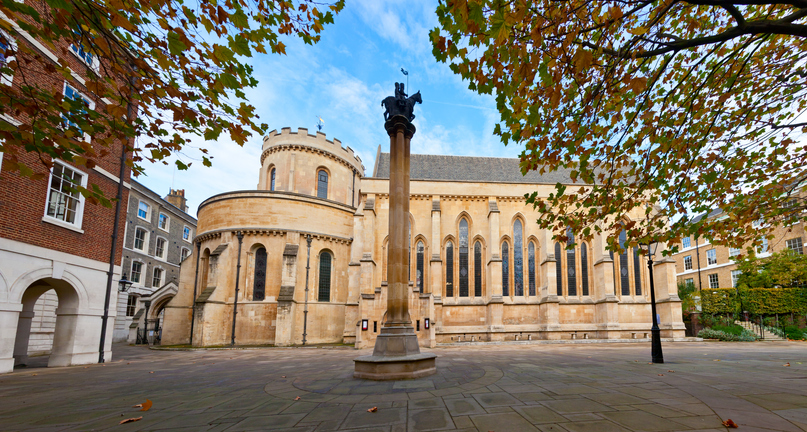
Some of you may be aware that a seal made its home under Hammersmith Bridge recently. Freddie, as he was affectionately known, was attacked by a dog on Saturday and, sadly, had to be euthanised as his injuries were too severe for him to survive. The report, which contains some distressing images, is available here.
Wednesday marked the birthday of William Morris, (1834-1896), textile designer, writer and political activist, who lived in Kelmscott and Hammersmith and therefore very much part of the Thames river.
Kelmscott Manor, now owned by the Society of Antiquaries of London, is normally open to visitors during the summer but is currently closed for refurbishment. The manor was Morris’ summer retreat He is buried in the graveyard of nearby St George’s. The William Morris Society houses a museum in Morris’ former home in Hammersmith, on the Thames Path. Although the museum is currently closed, they have a series of online events you can participate in to learn more.
The Oxford home of J R R Tolkien is up for sale. Tolkien lived at 20 Northmoor Road in north Oxford (between the Thames and the Cherwell) from 1930 to 1947 whilst a Professor at Oxford University. He wrote The Hobbit and The Lord of the Rings whilst living there. A crowdfunding campaign to purchase the property with the objective of creating a literary centre was unsuccessful, despite backing from Sir Ian McKellan and Martin Freeman.
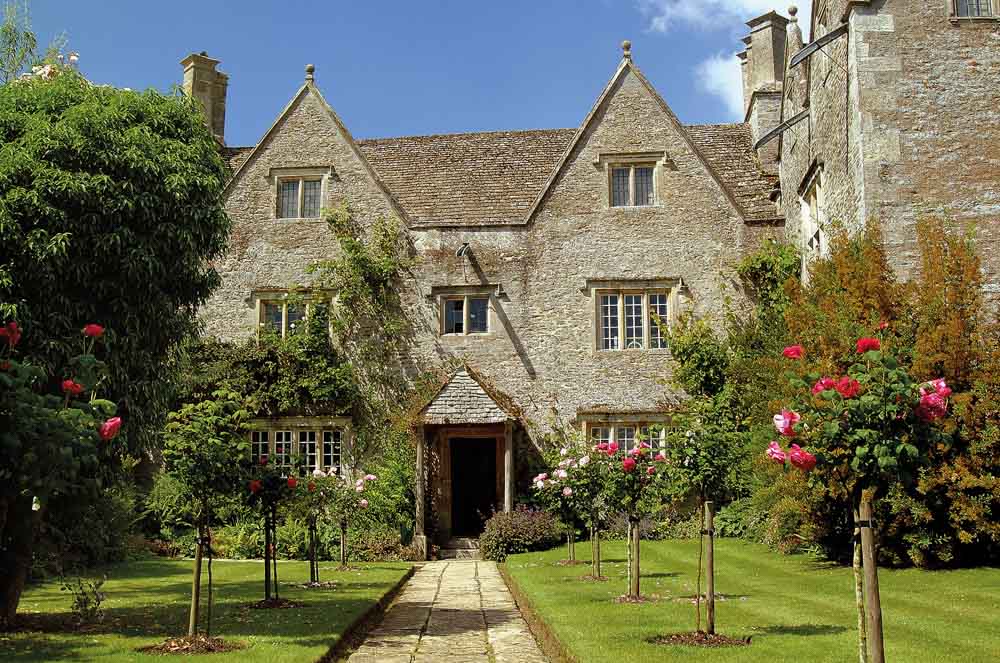
This morning we released the latest version of our route planner. We have made a number of changes which are detailed in a blog here. Highlights include changes to the swipe functionality on the maps, a how-to video, and a change in layout of texts and pictures. Why not take a look? We will be hosting a webinar on Tuesday March 30 at 2pm to walk through how to use the route planner.
Also, we have published an index of our “Closer Look” series in our newsletters ,complete with links, so that you can easily find where we have written about a section of the Thames Path.
Since there has been almost no rain for about two weeks, we have not had to update our Route Alerts page. The paths, though muddy in places, are predominantly dry. We have heard that, even in the Costwold Water Park, there are no issues with floodwater.
The weather this coming week seems to be wetter and we will keep an eye on the flood warnings.
We looked at Sonning back in August. So we are picking up this series from there and walking to Henley, a distance of just under six miles.
At Sonning we cross over to the left bank with a glorious view downstream of the Great House, one of three excellent hotels here. The path to Shiplake can be muddy underfoot. There are a number of long-term boat moorings here and one of the residents told us that, during the recent floods, the path was under a considerable amount of water, requiring waders. It was so deep that they worked in teams whenever they ventured out for provisions.
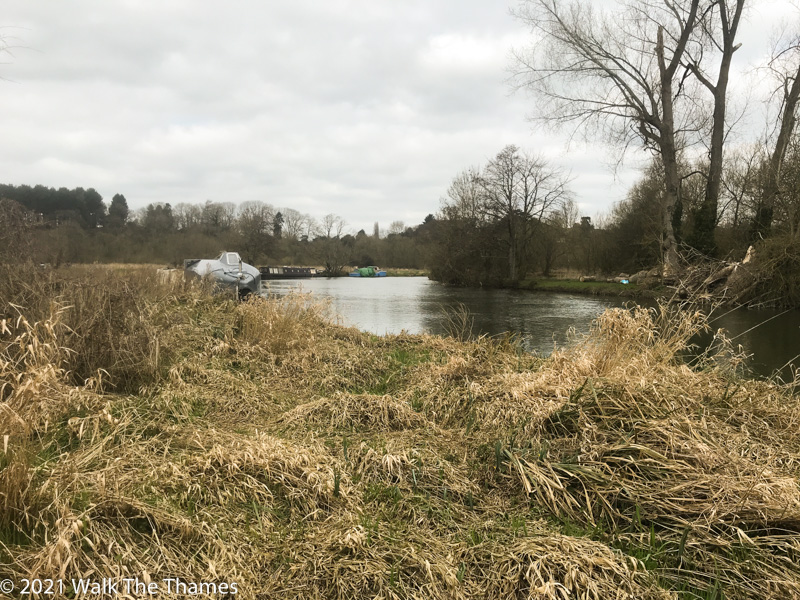
Our first encounter with Shiplake is the college, 2.1 miles from Sonning, standing a little up on a hill overlooking the river. Shiplake College is a relatively recent independent boys school, founded in 1959, although the distinctive red-brick buildings date back to 1890. It’s possible to leave the Thames Path here by taking a footpath behind the boathouse where you will reach Church Lane which leads off the busy A4155 Reading to Henley road.
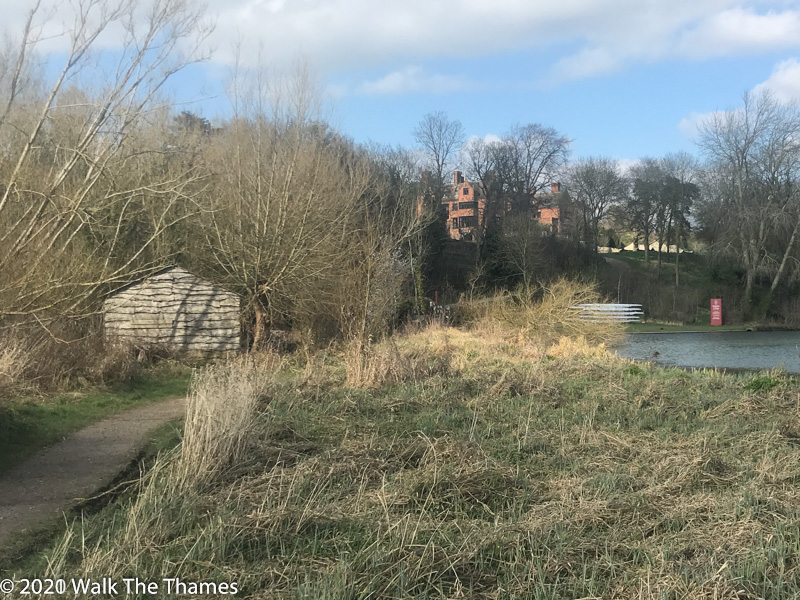
Possibly thinking you have now reached Shiplake you may be disappointed to find that you still have quite some way to walk. It’s a further 0.6 miles to the lock, which is presently closed. Even if it were open, you can’t progress further. A missing stretch of the tow path forces the Path away from the river and onto Mill Lane.
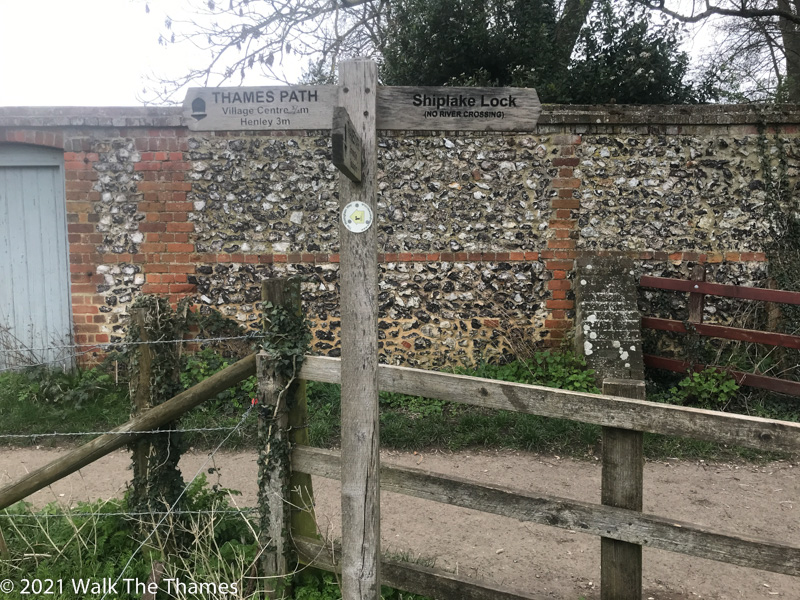
Historically the Thames Path crossed open fields to reach Mill Road which takes you into the village of Lower Shiplake, a journey of just 0.6 miles. Within the last year or so, a right of way has been established over some more of the riverbank so that you can now follow the river for 1.1 miles almost into the village. We stress almost because, at Lashbrook, tantalisingly close to the village, the right of way ends and we must divert across fields to Mill Road where we rejoin the former Thames Path. From Lashbrook to the village is a circuitous 0.6 miles making this route 1.7 miles long, 1.1 miles further.
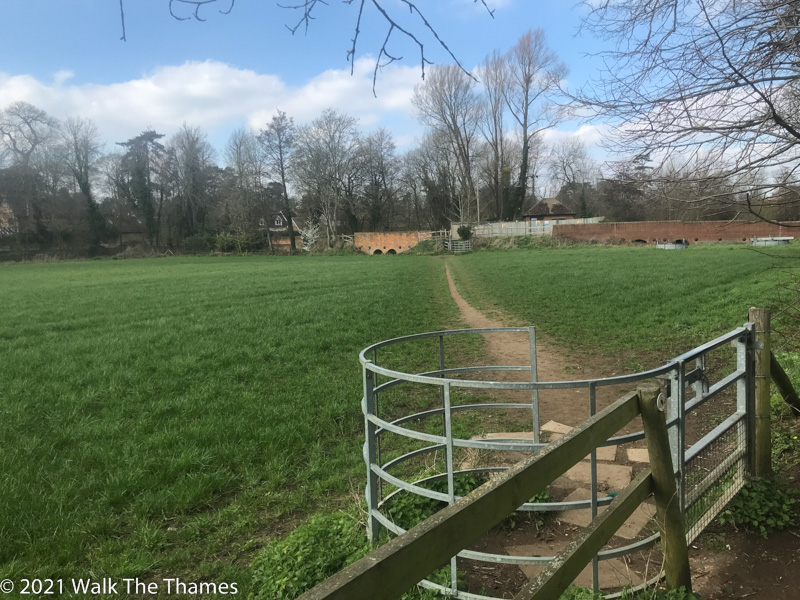
If you are neither tired, hungry or on a deadline, then you might as well follow the new route: there are some nice waterfront homes on the opposite bank of Wargrave. Having said that, the old route is not bad either. Mill Road, on which you will spend more time, is quiet and pleasant.
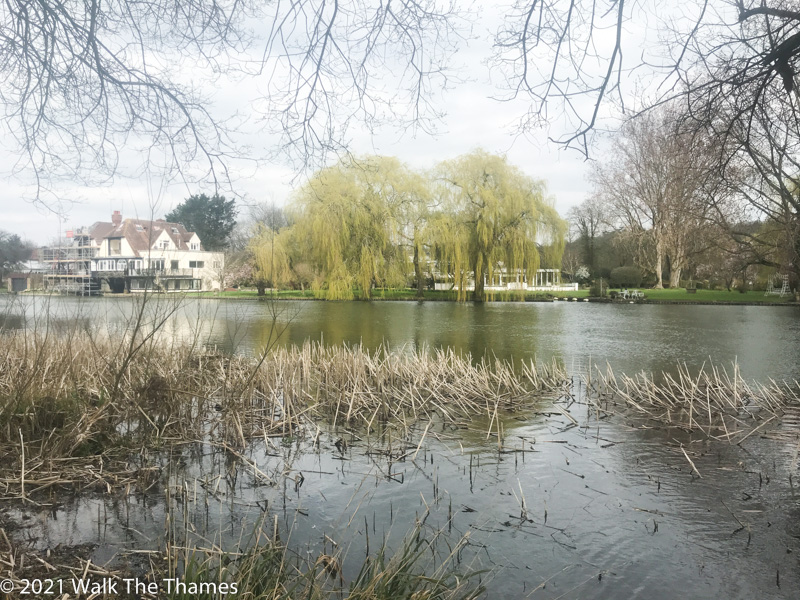
Lower Shiplake is graced with a post office, a pub (The Baskerville which also offers rooms), and a train station. What more do you need? The station sits on the branch line from Twyford to Henley and trains are frequent. Shiplake’s church of Saints Peter and Paul, is found close to the college and therefore out of reach. This is a shame because Alfred Lord Tennyson is buried there.
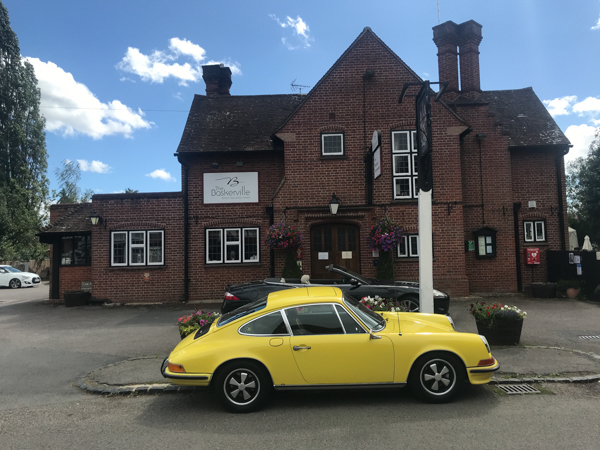
There is still no sign of the river, hidden by houses a couple of hundred yards away. In fact, we don’t see the river for another 0.8 miles until we pass Bolney Court. Instead we are forced to walk parallel to the river, along a pleasant and quiet tree-lined avenue, Bolney Road. In fact, it is all Bolney Court’s fault that we have the diversion from the river in the first place, not agreeing to a tow path in days gone by.
Bolney Court is hard to measure, given that we only see the back of the house. Its grounds must be quite extensive leading down to the river. It’s the house next door, Thames Side Court, that is most interesting. This was the home of the Swiss financier, Urs Schwarzenbach, who subsequently purchased Culham Court which the Thames Path goes past between Henley and Marlow. He had a miniature railway installed in the grounds modelled on St Moritz station. Both are visible from the Thames Path.
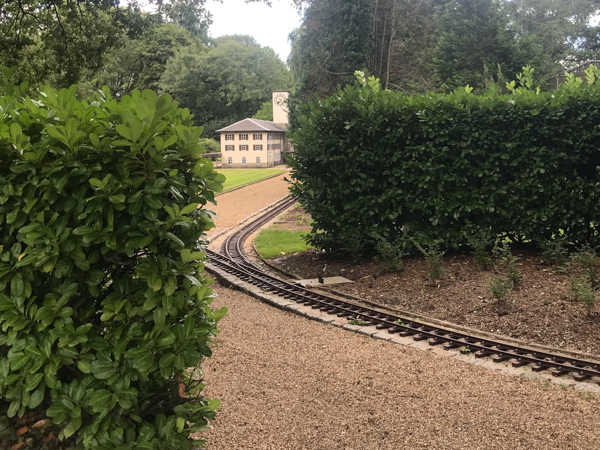
Past Thames Side Court we finally reach the river again and we have a lovely riverside walk through meadows. Across the river is Conway Bridge, which sits on the estate of Park Place, a Grade II listed 18th century country house. The bridge, built in 1763, was designed by Humphrey Gainsborough, brother of celebrated artist Thomas Gainsborough and carries traffic along the busy Wargrave to Henley Road over ornamental lawns belonging to the estate. The bridge was constructed with stone taken from the ruins of Reading Abbey. Park Place was sold in 2009 to the current owner, Andrey Borodin, a Russian banker, for £140 million. It was the most expensive house sale of that year.
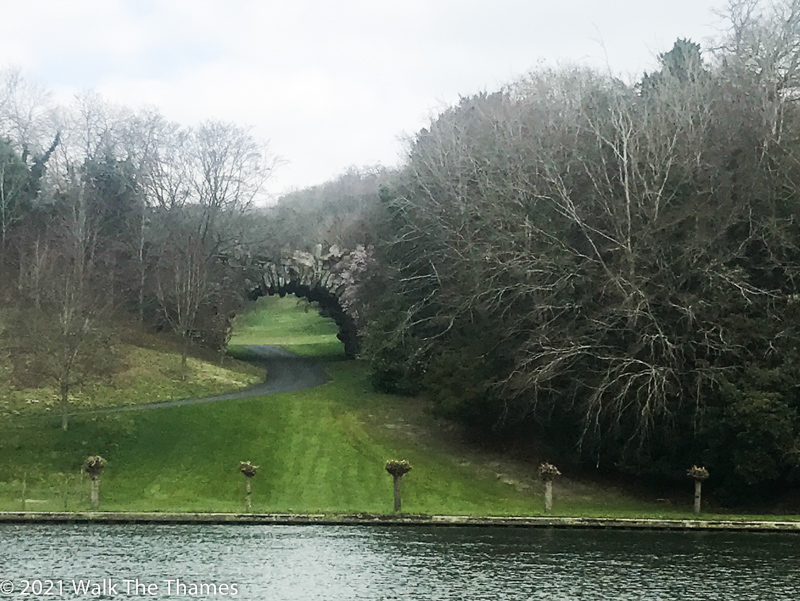
Shortly before Henley we arrive at Marsh Lock. The lock sits on the opposite side of the river and a series of boardwalks take us across, what is now quite a wide river, to the lock and back again. Excellent photo opportunities!
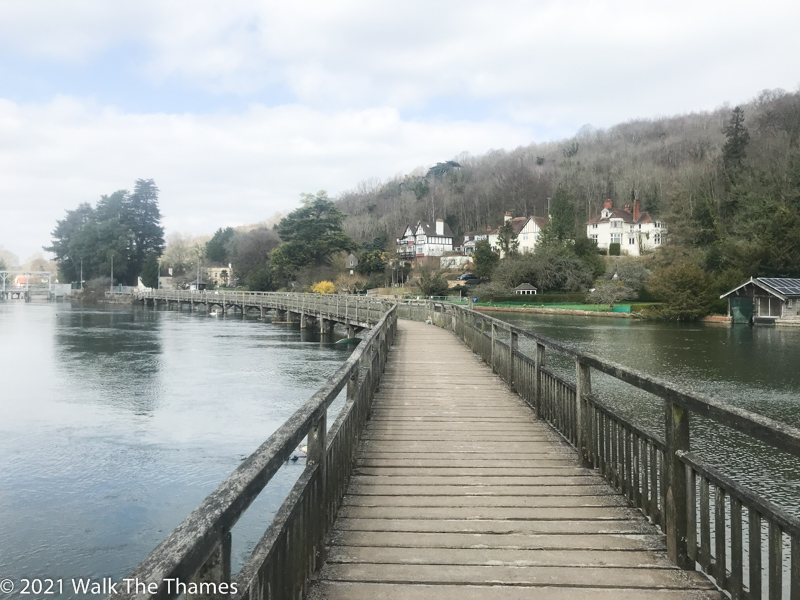
It’s just less than a mile from Marsh Lock to Henley bridge and, in summer, you may be forgiven for feeling a little out of place. The meadow soon turns into a park where you will find daytrippers picknicking. There’s a bandstand, ice cream vans, food kiosks, and toilets. It’s a big change from the marsh lands between Sonning and Shiplake. If you can spare the time, stop by the River and Rowing Museum.
Henley out of season is lovely. But if you’ve decided to walk the Thames Path to “get away from it all” then Henley in summer is the last place you want to be. Henley Regatta is very much on the social calendar, along with Ascot and Glyndebourne. You have been warned!
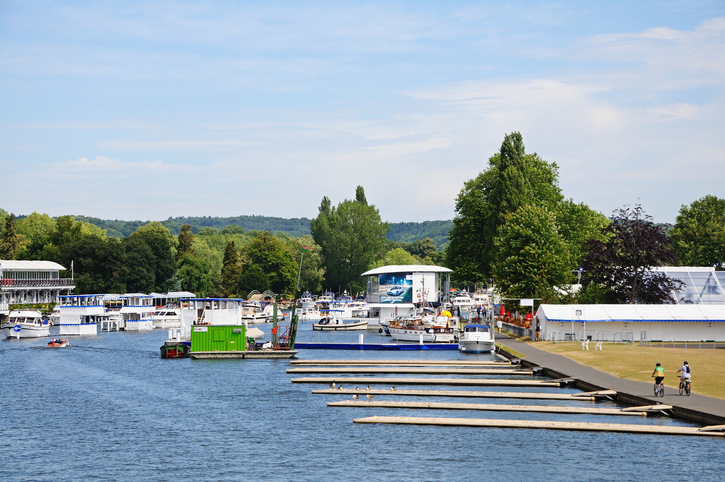
As next Friday is Good Friday and therefore a holiday, there will be no newsletter. The next one will be on Friday April 9 – which just happens to be the birthday of Isambard Kingdom Brunel. Have a good break!
Ready to book?
| Cookie | Duration | Description |
|---|---|---|
| cookielawinfo-checkbox-analytics | 11 months | This cookie is set by GDPR Cookie Consent plugin. The cookie is used to store the user consent for the cookies in the category "Analytics". |
| cookielawinfo-checkbox-functional | 11 months | The cookie is set by GDPR cookie consent to record the user consent for the cookies in the category "Functional". |
| cookielawinfo-checkbox-necessary | 11 months | This cookie is set by GDPR Cookie Consent plugin. The cookies is used to store the user consent for the cookies in the category "Necessary". |
| cookielawinfo-checkbox-others | 11 months | This cookie is set by GDPR Cookie Consent plugin. The cookie is used to store the user consent for the cookies in the category "Other. |
| cookielawinfo-checkbox-performance | 11 months | This cookie is set by GDPR Cookie Consent plugin. The cookie is used to store the user consent for the cookies in the category "Performance". |
| viewed_cookie_policy | 11 months | The cookie is set by the GDPR Cookie Consent plugin and is used to store whether or not user has consented to the use of cookies. It does not store any personal data. |